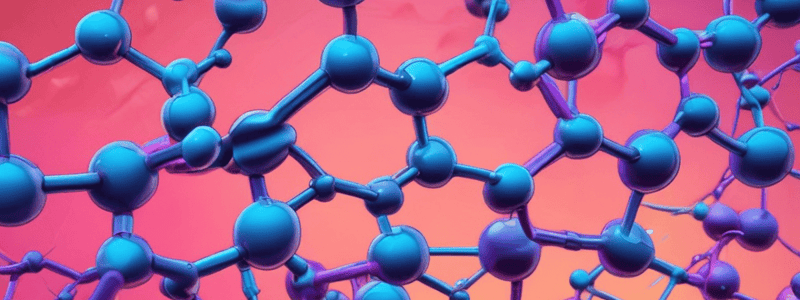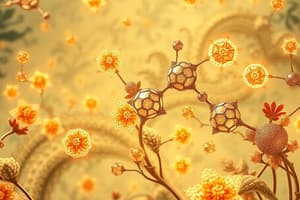Podcast
Questions and Answers
How is a covalent bond represented in Lewis structures?
How is a covalent bond represented in Lewis structures?
- As dots between atoms (correct)
- As a line
- As numbers
- As dashes around atoms
What electron configuration imparts special stability to noble gas elements?
What electron configuration imparts special stability to noble gas elements?
- Six electrons in the outermost shell
- Four electrons in the outermost shell
- Eight electrons in the outermost shell (correct)
- Ten electrons in the outermost shell
What determines the chemistry of main-group elements?
What determines the chemistry of main-group elements?
- The number of neutrons
- The tendency to mimic noble gases (correct)
- The atomic weight
- The number of protons
In Kekulé structures, how is a two-electron covalent bond indicated?
In Kekulé structures, how is a two-electron covalent bond indicated?
What results in a stable molecule according to the text?
What results in a stable molecule according to the text?
What is the role of hydrogen in Lewis structures?
What is the role of hydrogen in Lewis structures?
How many valence electrons does Carbon have?
How many valence electrons does Carbon have?
How many bonds does Hydrogen typically form?
How many bonds does Hydrogen typically form?
Why does Carbon need to form four bonds?
Why does Carbon need to form four bonds?
What is the spatial orientation of the four C-H bonds in methane?
What is the spatial orientation of the four C-H bonds in methane?
What happens when an s orbital hybridizes with three p orbitals?
What happens when an s orbital hybridizes with three p orbitals?
What does the superscript 3 in sp3 hybrid orbitals represent?
What does the superscript 3 in sp3 hybrid orbitals represent?
What is the angle formed by each H - C - H bond in sp3 hybrid orbitals?
What is the angle formed by each H - C - H bond in sp3 hybrid orbitals?
Which type of hybrid orbitals result in unsymmetrical orbitals about the nucleus?
Which type of hybrid orbitals result in unsymmetrical orbitals about the nucleus?
How many electron pairs are shared between atoms in a triple bond?
How many electron pairs are shared between atoms in a triple bond?
Which type of hybrid orbitals form a σ bond by head-on overlap?
Which type of hybrid orbitals form a σ bond by head-on overlap?
What is the structure of acetylene (HC ≡ CH) in terms of its carbon-carbon bond?
What is the structure of acetylene (HC ≡ CH) in terms of its carbon-carbon bond?
Which type of hybrid orbitals have an angle of 120° between the orbitals?
Which type of hybrid orbitals have an angle of 120° between the orbitals?
What is the special property of carbon that allows it to form a diverse range of compounds?
What is the special property of carbon that allows it to form a diverse range of compounds?
Why is carbon unique compared to other elements?
Why is carbon unique compared to other elements?
What is the overall charge of an atom?
What is the overall charge of an atom?
Which subatomic particles are found in the nucleus of an atom?
Which subatomic particles are found in the nucleus of an atom?
What allows carbon to form compounds ranging from simple methane to complex DNA?
What allows carbon to form compounds ranging from simple methane to complex DNA?
What has modern chemistry allowed scientists to do with organic compounds?
What has modern chemistry allowed scientists to do with organic compounds?
What type of bond is formed by the combination of an sp2–sp2 σ bond and a 2p–2p π bond?
What type of bond is formed by the combination of an sp2–sp2 σ bond and a 2p–2p π bond?
How many electrons are shared in the formation of a carbon–carbon double bond?
How many electrons are shared in the formation of a carbon–carbon double bond?
What type of hybrid orbital is needed to account for the triple bond in acetylene, H-C ≡ C-H?
What type of hybrid orbital is needed to account for the triple bond in acetylene, H-C ≡ C-H?
When two sp-hybridized carbon atoms approach each other, what type of bond is formed by the overlap of their sp hybrid orbitals?
When two sp-hybridized carbon atoms approach each other, what type of bond is formed by the overlap of their sp hybrid orbitals?
What happens when the pz orbitals from each carbon atom overlap during bonding?
What happens when the pz orbitals from each carbon atom overlap during bonding?
In sp hybridization, what is the orientation between the two resulting sp orbitals?
In sp hybridization, what is the orientation between the two resulting sp orbitals?
Sp3 hybrid orbitals form stronger bonds than unhybridized s or p orbitals.
Sp3 hybrid orbitals form stronger bonds than unhybridized s or p orbitals.
The angle formed by each H - C - H bond in sp3 hybrid orbitals is 120°.
The angle formed by each H - C - H bond in sp3 hybrid orbitals is 120°.
Ethylene contains a carbon–carbon triple bond.
Ethylene contains a carbon–carbon triple bond.
In sp2 hybridization, three sp2 hybrid orbitals result and one 2p orbital remains unchanged.
In sp2 hybridization, three sp2 hybrid orbitals result and one 2p orbital remains unchanged.
The three sp2 orbitals lie in a plane at angles of 180° to one another.
The three sp2 orbitals lie in a plane at angles of 180° to one another.
When two carbons with sp2 hybridization approach each other, they form a σ bond by sp2–sp2 side-on overlap.
When two carbons with sp2 hybridization approach each other, they form a σ bond by sp2–sp2 side-on overlap.
Hydrogen forms two covalent bonds because it has two valence electrons.
Hydrogen forms two covalent bonds because it has two valence electrons.
Lithium fluoride is formed by the transfer of one electron from fluorine to lithium.
Lithium fluoride is formed by the transfer of one electron from fluorine to lithium.
Ionic bonding occurs when valence electrons are completely transferred between atoms.
Ionic bonding occurs when valence electrons are completely transferred between atoms.
Carbon forms four covalent bonds due to needing four additional valence electrons to reach the neon configuration.
Carbon forms four covalent bonds due to needing four additional valence electrons to reach the neon configuration.
Covalent bonds result from the sharing of protons between atoms.
Covalent bonds result from the sharing of protons between atoms.
In methane (CH4), all four C-H bonds are identical in spatial orientation.
In methane (CH4), all four C-H bonds are identical in spatial orientation.
Sp3 hybrid orbitals are symmetrical about the nucleus.
Sp3 hybrid orbitals are symmetrical about the nucleus.
Energy is released from the chemical system when a bond is broken.
Energy is released from the chemical system when a bond is broken.
Carbon typically forms five bonds in its compounds.
Carbon typically forms five bonds in its compounds.
The superscript 3 in sp3 hybrid orbitals indicates how many electrons occupy the hybrid orbital.
The superscript 3 in sp3 hybrid orbitals indicates how many electrons occupy the hybrid orbital.
The tetrahedral orientation of sp3 hybrid orbitals results from the combination of an s orbital and two p orbitals.
The tetrahedral orientation of sp3 hybrid orbitals results from the combination of an s orbital and two p orbitals.
Atoms bond together because the resulting compound is less stable than the separate atoms.
Atoms bond together because the resulting compound is less stable than the separate atoms.
Carbon can form a triple bond by sharing six electrons.
Carbon can form a triple bond by sharing six electrons.
Sp hybrid orbitals result from the combination of a carbon 2s orbital with two p orbitals.
Sp hybrid orbitals result from the combination of a carbon 2s orbital with two p orbitals.
When two sp-hybridized carbon atoms approach each other, sp orbitals overlap to form a strong pi bond.
When two sp-hybridized carbon atoms approach each other, sp orbitals overlap to form a strong pi bond.
The combination of an sp2–sp2 σ bond and a 2p–2p π bond results in the sharing of six electrons.
The combination of an sp2–sp2 σ bond and a 2p–2p π bond results in the sharing of six electrons.
Two sp hybrid orbitals are oriented 180° apart on the y-axis.
Two sp hybrid orbitals are oriented 180° apart on the y-axis.
Py orbitals from each carbon overlap to form a py–py π bond by sideways overlap.
Py orbitals from each carbon overlap to form a py–py π bond by sideways overlap.
A stable molecule is formed when a noble-gas configuration is achieved for all the atoms.
A stable molecule is formed when a noble-gas configuration is achieved for all the atoms.
Covalent bonds are indicated as a line drawn between atoms in Lewis structures.
Covalent bonds are indicated as a line drawn between atoms in Lewis structures.
Carbon has four dots in its Lewis structure, representing its 1s electron.
Carbon has four dots in its Lewis structure, representing its 1s electron.
An octet of electrons in the valence shell provides special stability to noble gas elements.
An octet of electrons in the valence shell provides special stability to noble gas elements.
Kekulé structures represent covalent bonds as dots in Lewis structures.
Kekulé structures represent covalent bonds as dots in Lewis structures.
Main-group elements do not tend to take on the electron configuration of the nearest noble gas.
Main-group elements do not tend to take on the electron configuration of the nearest noble gas.
Flashcards are hidden until you start studying




